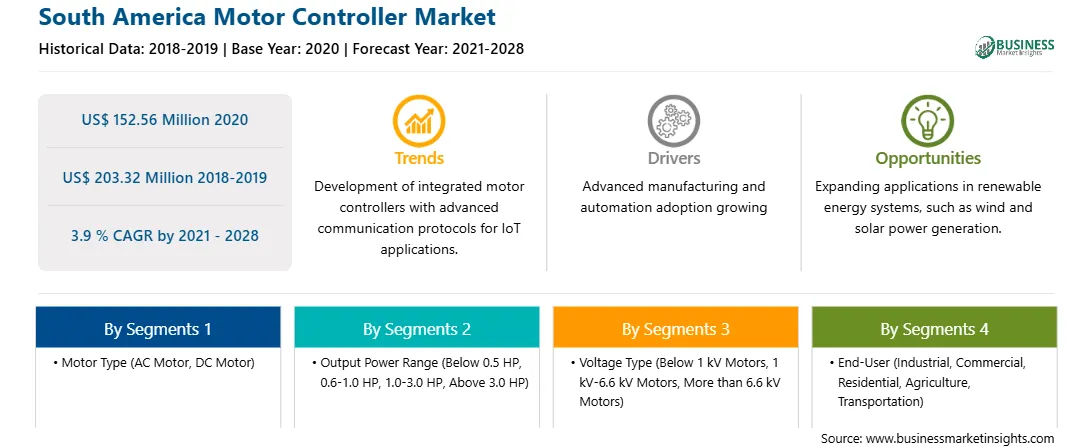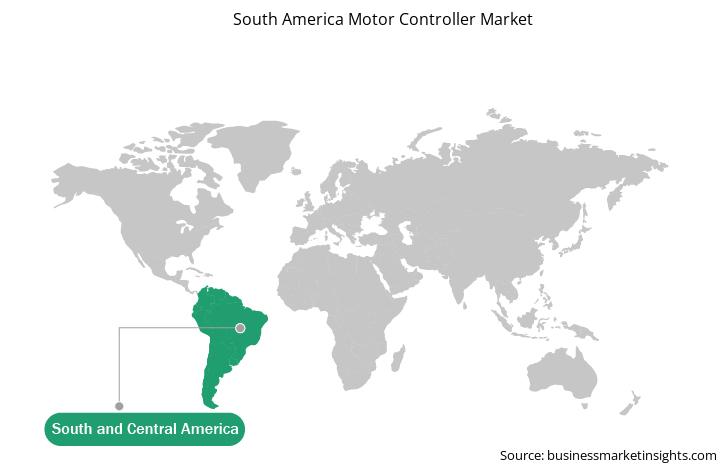SAM is segmented geographically into Brazil, Argentina, and the Rest of SAM. A mixed growth scenario characterizes the region, with many countries having complex political and macroeconomic environments. The region is known for its food production, and agriculture sector acts as a backbone of the region. Hence, the region has an abundant opportunity in food processing businesses, and the following business unit drives the motor controller market in the region. However, the automotive sector is not showing growth prospect and is reducing its manufacturing capacity in the region. For Instance, in January 2021, Ford Motor Co is planning to close its three plants in Brazil and stop producing automobiles in the South American country, which will have a negative impact on growth of the motor controller market. However, industries such as manufacturing, electronics, food & beverages, and aerospace are embracing the adoption of trade management in respective industries to ensure greater efficiency while reducing operational cost. This will further increase the demand for motor controller in the South America region. Further, the governments of other emerging economies in the region are taking several initiatives to support industrial growth. For instance, Argentina is concentrating on attracting FDI by taking several initiatives such as signing international bilateral agreements and removing restriction on foreign investment. These steps are anticipated to help in the development of businesses in South America, which will have a positive impact on the market.
In case of COVID-19, SAM is highly affected especially Brazil, which has reported the highest number of cases, followed by Ecuador, Chile, Peru, and Argentina, among others. Brazil is also a dominant contributor to the overall manufacturing capabilities of the region. The country witnessed a major decline in demand for automation solutions, following the drastic drop-in manufacturing activities and limited building construction activities amid the COVID-19 pandemic. As a result of lowered performance of the manufacturing, construction and oil & gas sectors, Brazil, as well as other SAM countries, registered low demand for motor controllers in 2020. However, with the relaxed measures in lockdown, the business operations in SAM region are slowly resuming, especially from last two quarters of 2020. Hence, the ongoing business operations resumption are expected to positively impact the motor controller market.

Strategic insights for the South America Motor Controller provides data-driven analysis of the industry landscape, including current trends, key players, and regional nuances. These insights offer actionable recommendations, enabling readers to differentiate themselves from competitors by identifying untapped segments or developing unique value propositions. Leveraging data analytics, these insights help industry players anticipate the market shifts, whether investors, manufacturers, or other stakeholders. A future-oriented perspective is essential, helping stakeholders anticipate market shifts and position themselves for long-term success in this dynamic region. Ultimately, effective strategic insights empower readers to make informed decisions that drive profitability and achieve their business objectives within the market.

| Report Attribute | Details |
|---|---|
| Market size in 2020 | US$ 152.56 Million |
| Market Size by 2028 | US$ 203.32 Million |
| Global CAGR (2021 - 2028) | 3.9 % |
| Historical Data | 2018-2019 |
| Forecast period | 2021-2028 |
| Segments Covered |
By Motor Type
|
| Regions and Countries Covered | South and Central America
|
| Market leaders and key company profiles |
The geographic scope of the South America Motor Controller refers to the specific areas in which a business operates and competes. Understanding local distinctions, such as diverse consumer preferences (e.g., demand for specific plug types or battery backup durations), varying economic conditions, and regulatory environments, is crucial for tailoring strategies to specific markets. Businesses can expand their reach by identifying underserved areas or adapting their offerings to meet local demands. A clear market focus allows for more effective resource allocation, targeted marketing campaigns, and better positioning against local competitors, ultimately driving growth in those targeted areas.

The SAM motor controller market is expected to grow from US$ 152.56 million in 2020 to US$ 203.32 million by 2028; it is estimated to grow at a CAGR of 3.9 % from 2021 to 2028. Surging intelligent motor controller across SAM region will escalate the SAM motor controller market. Motor controller equipment are evolving in terms of features and technologies, and the SAM motor controller market is expected to experience the availability and adoption of a wide range of intelligent motor controller solutions in the coming years. An intelligent motor controller is designed to meet the requirements of low-cost, 3-phase motor systems. It provides an equivalent or greater functionality compared to traditional motor controllers at economical costs, thereby intelligent motor controllers are maximizing the value of components in the plant. Further, the rising demand for smart, multifunctional, and integrated devices as well as the growing traction toward automation in industries such as oil & gas, water and wastewater management, power generation, and food & beverages are driving the SAM motor controller market growth. Intelligent motor controllers are employed in almost all major industries, including oil & gas, water and wastewater management, power generation, food & beverages, and metals & mining. With the advent of AI, manufacturers are likely to introduce motor controllers with improved overall performance as AI enables them to accomplish more complex tasks, which will drive the SAM motor controller market.
In terms of motor type, the AC motor segment accounted for the largest share of the SAM motor controller market in 2020. In terms of output power range, the 0.6 - 1.0 HP segment held a larger market share of the SAM motor controller market in 2020. In terms of voltage type, the below 1 kV motors segment held a larger market share of the SAM motor controller market in 2020. Further, the industrial segment held a larger share of the SAM motor controller market based on end-user in 2020.
A few major primary and secondary sources referred to for preparing this report on the SAM motor controller market are company websites, annual reports, financial reports, national government documents, and statistical database, among others. Major companies listed in the report are ABB Ltd., AMETEK Inc., Eaton Corporation plc, General Electric Company, Microchip Technology Inc., Nidec Corporation, and Parker-Hannifin Corporation.
The South America Motor Controller Market is valued at US$ 152.56 Million in 2020, it is projected to reach US$ 203.32 Million by 2028.
As per our report South America Motor Controller Market, the market size is valued at US$ 152.56 Million in 2020, projecting it to reach US$ 203.32 Million by 2028. This translates to a CAGR of approximately 3.9 % during the forecast period.
The South America Motor Controller Market report typically cover these key segments-
The historic period, base year, and forecast period can vary slightly depending on the specific market research report. However, for the South America Motor Controller Market report:
The South America Motor Controller Market is populated by several key players, each contributing to its growth and innovation. Some of the major players include:
The South America Motor Controller Market report is valuable for diverse stakeholders, including:
Essentially, anyone involved in or considering involvement in the South America Motor Controller Market value chain can benefit from the information contained in a comprehensive market report.